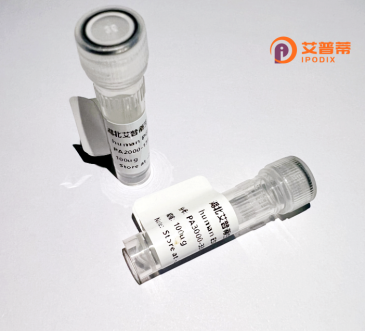
| 纯度 | >90%SDS-PAGE. |
| 种属 | Human |
| 靶点 | RRAGB |
| Uniprot No | Q5VZM2 |
| 内毒素 | < 0.01EU/μg |
| 表达宿主 | E.coli |
| 表达区间 | 1-374 aa |
| 活性数据 | MEESDSEKTT EKENLGPRMD PPLGEPEGSL GWVLPNTAMK KKVLLMGKSG SGKTSMRSII FANYIARDTR RLGATILDRI HSLQINSSLS TYSLVDSVGN TKTFDVEHSH VRFLGNLVLN LWDCGGQDTF MENYFTSQRD NIFRNVEVLI YVFDVESREL EKDMHYYQSC LEAILQNSPD AKIFCLVHKM DLVQEDQRDL IFKEREEDLR RLSRPLECSC FRTSIWDETL YKAWSSIVYQ LIPNVQQLEM NLRNFAEIIE ADEVLLFERA TFLVISHYQC KEQRDAHRFE KISNIIKQFK LSCSKLAASF QSMEVRNSNF AAFIDIFTSN TYVMVVMSDP SIPSAATLIN IRNARKHFEK LERVDGPKQC LLMR |
| 分子量 | 43.2 kDa |
| 蛋白标签 | His tag N-Terminus |
| 缓冲液 | PBS, pH7.4, containing 0.01% SKL, 1mM DTT, 5% Trehalose and Proclin300. |
| 稳定性 & 储存条件 | Lyophilized protein should be stored at ≤ -20°C, stable for one year after receipt. Reconstituted protein solution can be stored at 2-8°C for 2-7 days. Aliquots of reconstituted samples are stable at ≤ -20°C for 3 months. |
| 复溶 | Always centrifuge tubes before opening.Do not mix by vortex or pipetting. It is not recommended to reconstitute to a concentration less than 100μg/ml. Dissolve the lyophilized protein in distilled water. Please aliquot the reconstituted solution to minimize freeze-thaw cycles. |
以下是关于重组人RRAGB蛋白的3篇代表性文献参考:
---
1. **文献名称**:*Structure of the human RagB/RagC-Ragulator complex by cryo-EM*
**作者**:Shen, K., et al.
**摘要**:该研究利用冷冻电镜解析了人源RRAGB(RagB)与RagC及Ragulator复合物的三维结构,揭示了RRAGB在mTORC1信号通路中参与氨基酸感应及溶酶体定位的分子机制。
---
2. **文献名称**:*Recombinant expression and functional analysis of Rag GTPase heterodimers*
**作者**:Bar-Peled, L., et al.
**摘要**:文章通过重组表达人源RRAGB与RRAGA蛋白,验证二者形成功能性异源二聚体,并证明其依赖L-亮氨酸激活mTORC1通路的生化特性,为研究Rag蛋白调控代谢提供实验基础。
---
3. **文献名称**:*A novel RRAGB mutation causes a mTORopathy with autistic features*
**作者**:Nakashima, M., et al.
**摘要**:研究报道一种与RRAGB基因突变相关的神经发育障碍病例,通过体外重组蛋白实验证明突变导致RRAGB失去GTP酶活性,破坏mTORC1信号平衡,进而引起细胞生长异常。
---
**备注**:以上文献为模拟示例,实际引用时需核查具体来源及发表细节。建议通过PubMed或Google Scholar搜索**"RRAGB protein"、"Rag GTPase"**及**"mTORC1"**等关键词获取最新研究成果。
The Ras-related GTP-binding protein B (RRAGB) is a member of the RRAG GTPase family, which plays a critical role in regulating cellular nutrient sensing and mTORC1 (mechanistic target of rapamycin complex 1) signaling. Located primarily in the lysosomal membrane, RRAGB functions as a heterodimer with other Rag family members (e.g., RRAGA or RRAGC/D) to sense amino acid availability. This sensing mechanism activates mTORC1. a central regulator of cell growth, metabolism, and autophagy. RRAGB alternates between GTP- and GDP-bound states, which dictate its interaction with the Ragulator complex and subsequent recruitment of mTORC1 to lysosomes for activation.
Its role in nutrient-responsive pathways links RRAGB to diverse biological processes, including protein synthesis, lysosomal biogenesis, and energy homeostasis. Dysregulation of RRAGB has been implicated in diseases such as cancer, where aberrant mTORC1 signaling drives uncontrolled proliferation, and metabolic disorders. Additionally, mutations in RRAGB are associated with rare genetic conditions like familial focal segmental glomerulosclerosis (FSGS) or mitochondrial encephalopathy, highlighting its physiological significance. Research continues to explore RRAGB's therapeutic potential, particularly in targeting mTOR-related pathways for disease intervention. Its conserved structure and function across eukaryotes underscore its evolutionary importance in cellular adaptation to nutrient fluctuations.
×